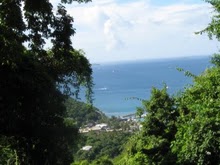 |
| Flock of Bohemian Waxwings |
The little forest down the street is only about a block and a half long and half a block wide, but it is packed full of a variety of wildlife. In the year and a half that I have been birding there regularly I have been introduced to at least twenty species of birds and have made many observations. The most interesting of those, is how the bird populations shift and change in this tiny patch of forest with the seasons.
 |
| Unidentified flycatcher |
 |
| Tennessee warbler |
During the summer of 2009, for instance, this forest was occupied by a nesting pair of Cooper's hawks and although I never saw the adults, I did get many photos of their two juveniles, who spent the summer learning to hunt and fend for themselves.
In January of 2010 a pair of Ravens set up their nest very near by. When the two Juvenile Cooper's hawks returned at the beginning of April to hunt the forest again, the Ravens chased them off almost immediately, being very intolerant of other predators in their territory, which tends to be very large. I saw the Ravens do so on a couple of occasion, after which I never saw the Cooper's hawks again.
 |
| Orange Crowned Warbler |
 |
| Ruby Crowned Kinglet |
From January to about mid April, 2010 the little forest was occupied mainly by two species of woodpecker and nuthatch, Chickadees, House finches, House Sparrows and shifting flocks of Bohemian waxwings. However, about the middle of the month I began to encounter some very rapid shifts in bird species population. Now there was a different species to be observed every few days, beginning with the Dark-eyed Junco, followed by the Ruby Crowned Kinglet, Orange Crowned Warbler, Tennessee Warbler and theYellow-rumped warbler.
 |
| Eastern Kingbird |
 |
| Swainson's thrush |
After a short break where few birds were seen, these were followed by the Gray flycatcher, the Western Tanager, Olive sided Flycatchers, Cedar Waxwings and eventually the Robin. By May the forest was occupied by a new variety of birds which included Yellow warblers, Cedar waxings, Chipping sparrows and a pair of Mallard ducks. The Chickadees and House finches were now spread out all over the neighborhood, while the Bohemian Waxwings had returned to the north and the colder climates that they enjoy.
 |
| Gray Flycatcher |
 |
| Juvenile Cooper's Hawk |
In the fall, the same rapid shift in bird population and occupation occurred, only in reverse, with the Dark-eyed Junco leaving last. But there were differences in the bird species I encountered this time. These included the American Redstart, House Wren, Ovenbird, Swainson's Thrush and Nelson's Sparrows. It is still amazing to me how such a small natural space can be a home, both temporary and permanent to such a large variety of birds and other wildlife. I'm certainly looking forward to what this spring will bring in the way of changes for the little forest this spring.
Enjoy,
Susan




















A nice article and a delightful site. Thanks.
ReplyDeleteGene
birdwatching-birds.blogspot.com